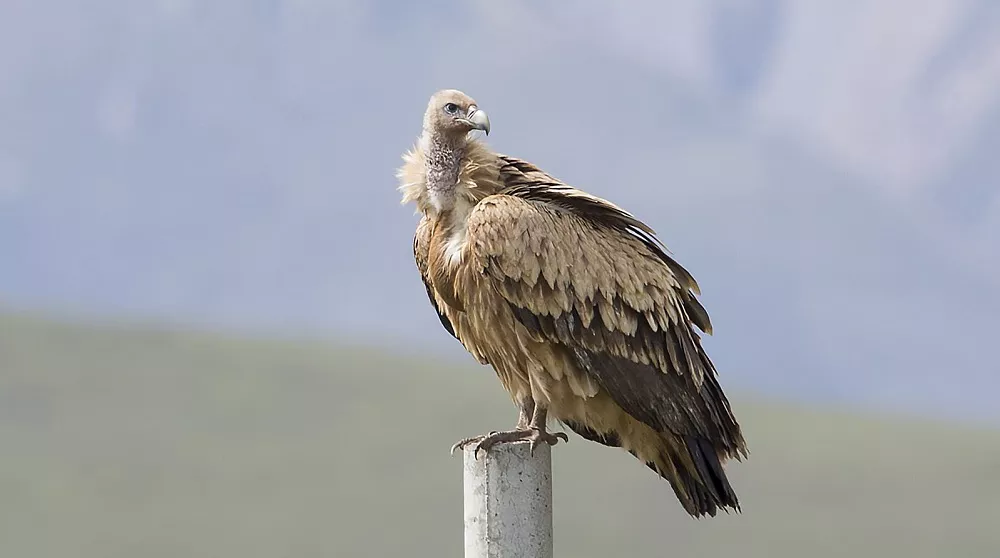The Himalayan vulture (Gyps himalayensis) or Himalayan griffon vulture is an Old World vulture native to the Himalayas and the adjoining Tibetan Plateau. It is one of the two largest Old World vultures and true raptors.
The Himalayan griffon vulture is a bird of the eagle family Hawk, with a total length of about 110 cm. Feather color changes greatly, the head and neck are bare, covered with dirty yellow or white down feathers, the feather cluster at the base of the neck is lanceolate, pale yellow or yellowish brown. The upper body and wing coverts are light yellowish brown, and the flight feathers are black. The underparts are light yellow or light yellow-brown, and the light-colored underparts and darker wings are in sharp contrast when flying.
What does Himalayan vulture look like?
The Himalayan griffon vulture is a large bird of prey. The upper part of the head and neck is covered with light yellow guard hairs, and the feathers on the lower neck gradually turn white and become down feathers. There are long and lanceolate tufts of feathers at the base of the neck to form collar feathers around the neck, pale yellow or yellowish brown , with a central white rachis. The back and wing coverts are light yellowish brown, the center of the feathers is browner, forming some irregular brown spots, the outer large coverts, flight feathers and tail feathers are dark brown, and the inner secondary flight feathers have light-colored tips. The upper chest is light brown, the rest of the lower body is light yellowish brown, the anal area and the undertail coverts are nearly white, with unclear rachis lines. Juvenile birds have brown heads and more down feathers than adults. The upper body is dark brown, the back, shoulder and wing coverts have thick yellow-white longitudinal stripes, and the primary flight feathers and tail feathers are dark brown. Underparts dark brown, with light-colored rachis.
The iris is dark yellow, milky yellow or light brown, the corners of the mouth are green or dark yellow, the cere is light brown or green brown, and the toes are greenish gray or white.
Himalayan griffon vulture size
Size measurement: weight 8000-12000 grams; body length 1200-1499 mm; mouth peak 71-81 mm; wings 755-805 mm; tail 365-402 mm; tarsus 110-126 mm.
Himalayan griffon vulture habitat
The Himalayan griffon vulture inhabits high mountains, alpine meadows, grasslands, deserts, Gobi and river valleys at an altitude of 2500-5500 meters. Most of them soar singly or in groups, and sometimes perch on higher rocks or hillsides.
Himalayan griffon vulture living habit
The Himalayan griffon vulture is a resident bird. It often soars at an altitude of 6,000 meters, looking for animal carcasses or wreckage in the air for a long time, and after finding them, it falls to the ground and tears up the food. It is one of the highest flying birds in the world. It can fly over Mount Everest, with a maximum flight altitude of more than 9,000 meters.
What do Himalayan vulture eat?
Feeds mainly on carrion and carcasses, and generally does not attack live animals. With extremely keen vision, it often hovers in the sky looking for corpses on the ground. There is fierce competition when eating, and sometimes they attack each other in order to compete for food. Sometimes frogs, lizards, birds, small mammals, and large beetles and locusts are also eaten when food is scarce or extremely hungry.
Because it seldom preys on living animals, its claws are obviously degenerated, but there are well-developed foot pads under the toes, which are conducive to running and beating on the ground. The Himalayan vulture’s beak has evolved to be extraordinarily powerful for tearing carrion or dragging heavy viscera from the carcasses of some large animals. In addition, in order to adapt to eating corpses, especially to extend the head and neck into the animal’s body cavity to eat internal organs or carrion, the feathers on the head and neck are specialized into short down feathers. Rubbing with earth, rocks, grass stems, shrubs, etc. restores the fluffy state, and continues to play an effective role in keeping warm. A circle of longer feathers growing at the base of the neck constitutes the collar, which prevents the feathers from being soiled, just like the napkins used when people eat. Due to its large body and wide wings, it is very suitable for saving energy during long-term and long-distance flying, and it is very beneficial for searching for animal carcasses that are difficult to obtain. When fighting for food, it always straightens its head, spreads its wings, erects the feathers on its shoulders, and keeps jumping forward, making threats to drive away other individuals.
Distribution area of Himalayan vulture
Distributed in Afghanistan, Bhutan, China, India, Kazakhstan, Kyrgyzstan, Malaysia, Mongolia, Nepal, Pakistan, Tajikistan, Thailand and Uzbekistan.
Mode of reproduction
The breeding season is from December to May of the following year. It usually nests in the recesses or niches of the cliffs and rock walls of plateaus, mountains, and canyons, and the old nests are often refurbished and continued to be used. Most of the nest materials are taken from nearby areas, mostly dead branches, and the inside is covered with soft materials, such as animal hair. When nest materials are scarce, they even pick up worn-out clothes, wire, etc. to build nests. Each clutch usually lays 1 egg, the color of the egg is white or dirty white, the surface is smooth without spots, and occasionally there are brown spots. Some breeding pairs nest alone, but most Himalayan vultures share nest areas during breeding season, and the distance between nests is usually not too far.


 Facebook
Facebook  Instagram
Instagram  Youtube
Youtube 